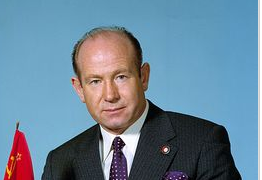Six years later, during a brief thaw in the cold war, he found himself training in Houston with Americans, larking around in a Stetson like a cowboy. On the joint Soyuz-Apollo Test Project that followed he and Tom Stafford bear-hugged in the docking tunnel between their craft, the first international handshake in space.
六年后,在冷戰時一個短暫的緩和時期,列昂諾夫在休斯頓和美國人一塊訓練,像個牛仔一樣,他戴著斯泰森氈帽到處閑逛。在隨后的聯盟-阿波羅聯合測試項目中,列昂諾夫和湯姆·斯塔福德·比爾在飛船對接隧道中擁抱,這是首次在太空中的國際性握手。
Later he and his new friends, whom he kept for life, drank each other's health in borscht which he had led them to believe was vodka. Space was not a place where men should be anything but brothers. Whenever he had time, from his first training into his retirement, he painted at his easel. Two subjects in particular he kept returning to. One was the air crash in 1968 that killed Gagarin, which he later officially investigated. He had been among the first to get to that awful scene of wreckage and snow, with the tops of the birch trees torn off by the impact. He had had to identify his friend's body. Death had never seemed closer, or so terrible.
后來列昂諾夫和他的新朋友們用羅宋湯為彼此的健康干杯,他誤導他們說這是伏特加。后來他們成為一生之友。太空應該是一個人們可以稱兄道弟的地方。他一有時間就在畫架上作畫,從第一次訓練到退休都是如此。他尤其經常回憶兩件事。其中之一是1968年導致加加林死亡的空難,他后來對此進行了正式調查。他是第一批到達那片廢墟和積雪的可怕景象的人之一,白樺樹的樹頂被撞得支離破碎。他不得不去辨認朋友的尸體。死亡從來沒有如此接近,如此糟糕。

Yet so far as there could be comfort, it came from his other constant subject, his walk in space. Beside the lovingly rendered module he floated again, sometimes with his hands out like an explorer, sometimes simply swimming, with his tether slack around him. Beyond him the sun blazed, a spotlight with a star's red aura round it; behind and below him lay Earth's blue. It was straight-out-of-the-tube blue, improbably bright. But that was what he had seen—and seen directly, out in empty space.
但是現在有一些安慰,它來自列昂諾夫的其它的連續項目,太空行走。在可愛的船艙旁邊,他又浮了起來,有時伸出雙手,像個探索者,有時就是簡單的游泳,身上的繩子放松開來。在列昂諾夫的身后,太陽閃耀著光芒,似一個帶著紅色光環的聚光燈;在他的后面和下面是地球的藍色。那是一種地道的藍色,亮得令人難以置信。但這就是他所看到的——而且是直接在空蕩的空間里看到的。
譯文由可可原創,僅供學習交流使用,未經許可請勿轉載。












